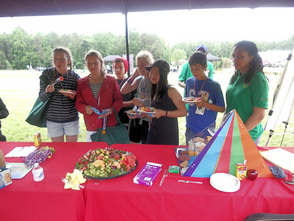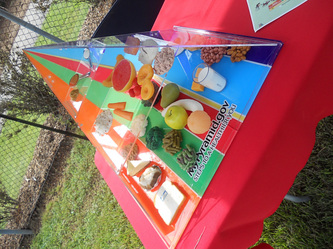Annual NBC Health & Fitness Expo

I have been participating in the Annual NBC Health Expo for the past two years under the University of the District of Columbia Dietetics Association. If you happen to be in the Washington D.C area please feel free to come out and support.
As students in the dietetics program at the University of the District of Columbia we address basic nutritional questions and explain interesting models. Please note that there is always a Registered Dietitian present.
As students in the dietetics program at the University of the District of Columbia we address basic nutritional questions and explain interesting models. Please note that there is always a Registered Dietitian present.
Promoting Healthy Food Choices at the University of the District of Columbia Agricultural Experiment Station

I volunteered today representing the University of the District of Columbia Dietetics Association at the University of the District of Columbia Agricultural Experiment Station to promote the exercising of healthy food choices and had a blast. Children from DC public schools toured the Agricultural Experiment Station and judging by their expressions, I know that they enjoyed the day and took with them a wealth of information.
Why Is Learning About Nutrition Important At A Young Age?
Nutrition is very important for everyone, but it is especially important for children because it is directly linked to all aspects of their growth and development; factors which will have direct ties to their level of health as adults. For example, a child with the right balance of omega fatty acids in their daily diet has a much better chance at creating a more solid foundation for their brain activity and capabilities later on.
Another huge reason why nutrition is so important for children is because they simply don’t know enough on their own to naturally choose to eat well. Unfortunately, the foods and snacks that taste the best are usually the worst for our bodies, and a child left to choose on their own will almost always choose junk food over fruits and vegetables simply because of the taste.
Why Is Learning About Nutrition Important At A Young Age?
Nutrition is very important for everyone, but it is especially important for children because it is directly linked to all aspects of their growth and development; factors which will have direct ties to their level of health as adults. For example, a child with the right balance of omega fatty acids in their daily diet has a much better chance at creating a more solid foundation for their brain activity and capabilities later on.
Another huge reason why nutrition is so important for children is because they simply don’t know enough on their own to naturally choose to eat well. Unfortunately, the foods and snacks that taste the best are usually the worst for our bodies, and a child left to choose on their own will almost always choose junk food over fruits and vegetables simply because of the taste.

CHANGING THE HEALTH TRAJECTORY FOR OLDER ADULTS THROUGH EFFECTIVE DIET AND ACTIVITY MODIFICATIONS PROJECT DIRECTOR: Ganganna, P. Rice, W. PERFORMING ORGANIZATION
BIOLOGY
UNIV OF THE DISTRICT OF COLUMBIA
WASHINGTON,DC 20008 NON TECHNICAL SUMMARY: Inadequate diet and lack of physical activity are the roots of many of the chronic diseases and disabilities that plague our older population. Approximately 35% of adults over the age of 75 have 3 or more chronic conditions, including, hypertension, heart disease, diabetes, arthritis, and macular degeneration/blindness. Ethnic minorities and low income populations are most at risk. Older adults fall short of meeting both nutrition (fruit, vegetable and whole grain) and physical activity goals of Healthy People 2010 (USDHHS, 2000). Only 6% of older adults consume at least three daily servings of vegetables (with at least one-third of these servings being dark green or orange vegetables) and only 4% of older women and 11% of older men consume at least six daily servings of grain products (with at least three being whole grain). Currently, only 10% of adults 64-74 years, and 7% of those 75 plus years engage in physical activities that enhance and maintain strength and endurance 2 plus days per week. Similar statistics describe those who engage in physical activities promoting development and maintenance of cardiorespiratory fitness. Evidence is mounting to demonstrate that changes in diet and exercise that are implemented in the later years can be effective in both extending life and improving quality of life. However, there is also the need to examine factors in earlier years that may curb the chronic conditions affecting quality of life for elders. The project described herein builds on earlier work by a team of scientists. This multi-state project includes interventions to increase physical activity in combination with interventions to increase consumption of fruits, vegetables and whole grains and a determination of lifestyle choices (including number of pregnancies and breast feeding earlier in life)as factors related to the incidence of chronic conditions, including macular degeneration or blindness in later years. There is clearly a need for additional research that will lead to improvements in both diet and exercise behaviors in older Americans, and that will address health disparities that exist among the elderly and those from minority groups and of lower socioeconomic status. Outcomes or projected Impacts: 1) 50% of older adults participating in the Washington, D.C. congregate meal sites will improve their diet with respect to increasing their intake of fruits, vegetables, and whole grains. OBJECTIVES: The goal of this project is to motivate elderly Washington, D.C. residents to increase their consumption of fruits and vegetables. The objective of this project is to examine novel interventions to increase fruit, vegetable and whole grain intake and physical activity in older adults. DC-AES will lead an experiment to design and evaluate a motivational curriculum and modified recipes to increase fruits and vegetables in a multicultural population of older adults. The specific objectives of this experiment are: (1) to investigate and compare the priorities of high fruit and vegetable consumers with low fruit and vegetable consumers; (2) to design new and innovative fun filled games and activities through which nutrition education can be effectively rendered; and (3) to collect traditional recipes from the elderly, modify the ingredients and method of cooking to improve the vegetable content and nutrient density, and publish a recipe book containing both the original and the modified recipes. Outputs: 1) Development and pre-testing of an educational curriculum designed to increase whole grain food consumption in older adults; and 2) A culturally sensitive recipe book with traditional recipes collected from participants to motivate participants to use familiar recipes with healthier modifications. APPROACH: Increasingly, strategies and tools are available to assess whether environments are supportive of positive dietary and physical activity behaviors (CDC, 2008; Glanz et al., 2007; Lee et al., 2008). However, few tools address increasing whole grain consumption in populations or strategies specific to older adults, such as through senior gardening programs, Senior Farmer's Market Coupon Program, or senior centers. A survey to identify perceived and desired environments that would promote fruit, vegetable and whole grain consumption and physical activity in older adults of diverse racial/ethnic and socioeconomic backgrounds will be developed in collaboration with participating stations and administered to elder service agency staff, nutrition professionals and community members of a food policy council in western Massachusetts. The survey will include perceived dietary intake and access issues in older adults, perceived availability of healthful foods and access to physical activity in the community, and recommendations for improving the local environment related to fruits, vegetables, whole grains and physical activity. As a result, a food environment tool tailored to the needs of older adults will be developed to assess the local community, and findings will be reported to local elder service agencies and food policy councils. Short-term environmental changes in food availability will be piloted as a result of selected food policy actions based on assessed needs. The tool developed as part of this experiment will also be disseminated to other states for wider community usage. CRIS NUMBER: 0221086 SUBFILE: CRIS
PROJECT NUMBER: DC-002NE1039 SPONSOR AGENCY: NIFA
PROJECT TYPE: HATCH PROJECT STATUS: NEW MULTI-STATE PROJECT NUMBER: NE-1039
START DATE: Oct 1, 2009 TERMINATION DATE: Sep 30, 2014
GRANT PROGRAM: (N/A)
GRANT PROGRAM AREA: (N/A)
CLASSIFICATION Knowledge Area (KA) Subject (S) Science (F) Objective (G) Percent 703 6010 3020 5.2 100% CLASSIFICATION HEADINGS
KA703 - Nutrition Education and Behavior
S6010 - Individuals
F3020 - Education
G5.2 - Promote Healthier Eating Habits and Lifestyles
RESEARCH EFFORT CATEGORIES
BASIC 50% APPLIED 50% DEVELOPMENTAL (N/A)%
KEYWORDS: health~trajectory~elderly~nutrition~dietary intake~fruit~vegetables~whole grains~physical activity~chronic disease risk~lifestyle
PROGRESS: Jan 1, 2010 TO Dec 31, 2010
OUTPUTS: Explicit objectives for this project were delineated in order to design and implement intervention strategies that will increase fruit, vegetable, and whole grain consumption in the multicultural elderly population in the District of Columbia. A survey questionnaire was constructed to address these objectives. The detailed survey instrument was field tested and validated for a test sample of 16 elderly African American subjects. The field test determined that the process of administering the survey instrument disseminates nutritional knowledge to subjects. PARTICIPANTS: The project is lead by the principal investigator, Prema Gangana, Ph.D., R.D. and the research associate and statistician, William Rice, M.A.T. Five undergraduate nutrition majors are research assistants: Ilka Harrigan; Camilla Henry; Kendra Hill-Bailey; Stephanie Howard; and Agata Williams. Research assistants were given intensive training in cognitive interview techniques as well as training in communicating nutritional information. Volunteer subjects for the project are registered participants from 59 District of Columbia congregate senior sites. TARGET AUDIENCES: Elderly individuals (aged 65 and above) who are residents of the District of Columbia are the intended audience for the project. Intervention strategies will address data that reflect nutritional risk. A subgroup of interest of this population includes those elderly who provide significant care to children. The assumption is that nutritional habits of members of this group will affect the nutritional habits of the children for whom they provide care. Special interventions may be needed for this subgroup. PROJECT MODIFICATIONS: Nothing significant to report during this reporting period.
IMPACT: 2010-01-01 TO 2010-12-31 Subjects complete the survey instrument through cognitive interviews conducted by research assistants. This interview technique not only collects quantitative and qualitative data, but also provides the opportunity for interviewers to respond to subjects and provide useful nutritional information and feedback.
PUBLICATION INFORMATION: 2010-01-01 TO 2010-12-31
No publications reported this period
PROJECT CONTACT INFORMATION NAME: Wyche-Moore, G. S. PHONE: 202-274-6656 FAX: 202-274-7113
Please see link for more information: http://www.reeis.usda.gov/web/crisprojectpages/221086.html
BIOLOGY
UNIV OF THE DISTRICT OF COLUMBIA
WASHINGTON,DC 20008 NON TECHNICAL SUMMARY: Inadequate diet and lack of physical activity are the roots of many of the chronic diseases and disabilities that plague our older population. Approximately 35% of adults over the age of 75 have 3 or more chronic conditions, including, hypertension, heart disease, diabetes, arthritis, and macular degeneration/blindness. Ethnic minorities and low income populations are most at risk. Older adults fall short of meeting both nutrition (fruit, vegetable and whole grain) and physical activity goals of Healthy People 2010 (USDHHS, 2000). Only 6% of older adults consume at least three daily servings of vegetables (with at least one-third of these servings being dark green or orange vegetables) and only 4% of older women and 11% of older men consume at least six daily servings of grain products (with at least three being whole grain). Currently, only 10% of adults 64-74 years, and 7% of those 75 plus years engage in physical activities that enhance and maintain strength and endurance 2 plus days per week. Similar statistics describe those who engage in physical activities promoting development and maintenance of cardiorespiratory fitness. Evidence is mounting to demonstrate that changes in diet and exercise that are implemented in the later years can be effective in both extending life and improving quality of life. However, there is also the need to examine factors in earlier years that may curb the chronic conditions affecting quality of life for elders. The project described herein builds on earlier work by a team of scientists. This multi-state project includes interventions to increase physical activity in combination with interventions to increase consumption of fruits, vegetables and whole grains and a determination of lifestyle choices (including number of pregnancies and breast feeding earlier in life)as factors related to the incidence of chronic conditions, including macular degeneration or blindness in later years. There is clearly a need for additional research that will lead to improvements in both diet and exercise behaviors in older Americans, and that will address health disparities that exist among the elderly and those from minority groups and of lower socioeconomic status. Outcomes or projected Impacts: 1) 50% of older adults participating in the Washington, D.C. congregate meal sites will improve their diet with respect to increasing their intake of fruits, vegetables, and whole grains. OBJECTIVES: The goal of this project is to motivate elderly Washington, D.C. residents to increase their consumption of fruits and vegetables. The objective of this project is to examine novel interventions to increase fruit, vegetable and whole grain intake and physical activity in older adults. DC-AES will lead an experiment to design and evaluate a motivational curriculum and modified recipes to increase fruits and vegetables in a multicultural population of older adults. The specific objectives of this experiment are: (1) to investigate and compare the priorities of high fruit and vegetable consumers with low fruit and vegetable consumers; (2) to design new and innovative fun filled games and activities through which nutrition education can be effectively rendered; and (3) to collect traditional recipes from the elderly, modify the ingredients and method of cooking to improve the vegetable content and nutrient density, and publish a recipe book containing both the original and the modified recipes. Outputs: 1) Development and pre-testing of an educational curriculum designed to increase whole grain food consumption in older adults; and 2) A culturally sensitive recipe book with traditional recipes collected from participants to motivate participants to use familiar recipes with healthier modifications. APPROACH: Increasingly, strategies and tools are available to assess whether environments are supportive of positive dietary and physical activity behaviors (CDC, 2008; Glanz et al., 2007; Lee et al., 2008). However, few tools address increasing whole grain consumption in populations or strategies specific to older adults, such as through senior gardening programs, Senior Farmer's Market Coupon Program, or senior centers. A survey to identify perceived and desired environments that would promote fruit, vegetable and whole grain consumption and physical activity in older adults of diverse racial/ethnic and socioeconomic backgrounds will be developed in collaboration with participating stations and administered to elder service agency staff, nutrition professionals and community members of a food policy council in western Massachusetts. The survey will include perceived dietary intake and access issues in older adults, perceived availability of healthful foods and access to physical activity in the community, and recommendations for improving the local environment related to fruits, vegetables, whole grains and physical activity. As a result, a food environment tool tailored to the needs of older adults will be developed to assess the local community, and findings will be reported to local elder service agencies and food policy councils. Short-term environmental changes in food availability will be piloted as a result of selected food policy actions based on assessed needs. The tool developed as part of this experiment will also be disseminated to other states for wider community usage. CRIS NUMBER: 0221086 SUBFILE: CRIS
PROJECT NUMBER: DC-002NE1039 SPONSOR AGENCY: NIFA
PROJECT TYPE: HATCH PROJECT STATUS: NEW MULTI-STATE PROJECT NUMBER: NE-1039
START DATE: Oct 1, 2009 TERMINATION DATE: Sep 30, 2014
GRANT PROGRAM: (N/A)
GRANT PROGRAM AREA: (N/A)
CLASSIFICATION Knowledge Area (KA) Subject (S) Science (F) Objective (G) Percent 703 6010 3020 5.2 100% CLASSIFICATION HEADINGS
KA703 - Nutrition Education and Behavior
S6010 - Individuals
F3020 - Education
G5.2 - Promote Healthier Eating Habits and Lifestyles
RESEARCH EFFORT CATEGORIES
BASIC 50% APPLIED 50% DEVELOPMENTAL (N/A)%
KEYWORDS: health~trajectory~elderly~nutrition~dietary intake~fruit~vegetables~whole grains~physical activity~chronic disease risk~lifestyle
PROGRESS: Jan 1, 2010 TO Dec 31, 2010
OUTPUTS: Explicit objectives for this project were delineated in order to design and implement intervention strategies that will increase fruit, vegetable, and whole grain consumption in the multicultural elderly population in the District of Columbia. A survey questionnaire was constructed to address these objectives. The detailed survey instrument was field tested and validated for a test sample of 16 elderly African American subjects. The field test determined that the process of administering the survey instrument disseminates nutritional knowledge to subjects. PARTICIPANTS: The project is lead by the principal investigator, Prema Gangana, Ph.D., R.D. and the research associate and statistician, William Rice, M.A.T. Five undergraduate nutrition majors are research assistants: Ilka Harrigan; Camilla Henry; Kendra Hill-Bailey; Stephanie Howard; and Agata Williams. Research assistants were given intensive training in cognitive interview techniques as well as training in communicating nutritional information. Volunteer subjects for the project are registered participants from 59 District of Columbia congregate senior sites. TARGET AUDIENCES: Elderly individuals (aged 65 and above) who are residents of the District of Columbia are the intended audience for the project. Intervention strategies will address data that reflect nutritional risk. A subgroup of interest of this population includes those elderly who provide significant care to children. The assumption is that nutritional habits of members of this group will affect the nutritional habits of the children for whom they provide care. Special interventions may be needed for this subgroup. PROJECT MODIFICATIONS: Nothing significant to report during this reporting period.
IMPACT: 2010-01-01 TO 2010-12-31 Subjects complete the survey instrument through cognitive interviews conducted by research assistants. This interview technique not only collects quantitative and qualitative data, but also provides the opportunity for interviewers to respond to subjects and provide useful nutritional information and feedback.
PUBLICATION INFORMATION: 2010-01-01 TO 2010-12-31
No publications reported this period
PROJECT CONTACT INFORMATION NAME: Wyche-Moore, G. S. PHONE: 202-274-6656 FAX: 202-274-7113
Please see link for more information: http://www.reeis.usda.gov/web/crisprojectpages/221086.html



